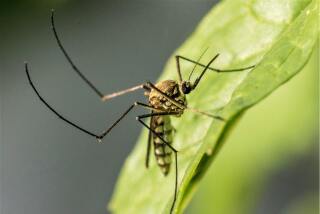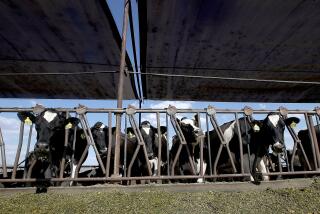Fever Cases Up; Fires Suspected
Ventura County health officials said last fall’s wildfires may be to blame for a spike in cases of valley fever, a flu-like disease transmitted by an airborne fungus.
More than 70 cases have been reported since October, with two-thirds of those occurring in the eastern portion of the county, where the Simi fire scorched more than 108,000 acres, officials said. This compares with a typical occurrence of two cases per month.
“If you live in this area [Southern California], you’re at risk for getting” the disease, said Dr. Robert Levin, Ventura County’s public health officer. “I cannot be sure, but it is logical that [brush fires are] the cause” of the increase in the disease, technically called coccidioidomycosis or cocci.
The fires wiped out vegetation and ground cover, leaving exposed soil that contains fungal spores, Levin said. The spores are then transmitted by dust particles kicked up by strong winds.
About 60% of those who become infected don’t have symptoms, he said, but those who become ill may experience fever, respiratory problems, coughs, headaches, muscle aches and rashes. Valley fever can lead to pneumonia or meningitis, which can be deadly.
People with weakened immune systems, including people infected with HIV, are at risk for developing a more severe form of valley fever, which moves the disease from the lungs to other parts of the body, including joints, bones, tissues and the nervous system.
Pregnant women, people who are diabetic and certain ethnic groups -- people of African American, Filipino and Latino descent -- are believed to be at greater risk of getting this form of the disease.
The last time Ventura County had an outbreak of valley fever was after the 1994 Northridge earthquake. Between January and March of that year, 203 cases were reported, compared with about 50 the year before. A 71-year-old Simi Valley man died of the illness, and dozens of other people were hospitalized.
Ventura County is not the only fire-ravaged county that has seen a rise in valley fever cases this year. San Bernardino County, where more than 60,000 acres were burned last fall, has seen nearly as many cases in the past three months as in all of last year. “So far this year, we’ve had 13 cases,” said Kim Woods, an epidemiologist at the San Bernardino County Department of Public Health. “In 2003 we only had 14 cases.”
Woods said his office planned to gather data to see if infections were occurring in the same areas, which would help establish any potential patterns. “We all knew Ventura had a problem,” Woods added, “but now the rest of us are saying ‘Oh, we might too.’ ”
In San Diego County, where 280,000 acres burned last October, officials have seen a slight increase in the number of reported cases of valley fever. Since Nov. 1, the county has recorded 34 cases, more than double the number in the nearly five-month period a year earlier, but fewer than the 40 reported from November to January two years ago.
Dr. Michele Ginsberg, chief of community epidemiology for the San Diego County Department of Health and Human Services, said her office asked state officials this week to prepare a study of counties affected by the wildfires to determine whether there were any verifiable links to the number of valley fever cases.
“I haven’t seen it proven, but I can understand, in theory, how it could be a factor. To tie it to an event like the fires you would need more specific information from the patients,” Ginsberg said. “It’s something for the medical community to consider, certainly.”
Since last fall, she said, the disease has been listed as a factor on three death certificates.
“I don’t know if people need to be overly concerned,” Ginsberg said. “Most people who are exposed will not become ill. Of those who do become ill, acute infection is usually limited -- the person will usually recover on their own and will not need medication for treatment.”
So far, valley fever has not increased in Los Angeles County. For more information about valley fever, see the Centers for Disease Control and Prevention’s website at https://www.cdc.gov.
Times staff writer William Wan contributed to this report.
More to Read
Sign up for Essential California
The most important California stories and recommendations in your inbox every morning.
You may occasionally receive promotional content from the Los Angeles Times.









